Unit 2: Fluid Statics
This section will study the forces acting on or generated by fluids at rest.
Objectives
- Introduce the concept of pressure;
- Prove it has a unique value at any particular elevation;
- Show how it varies with depth according to the hydrostatic equation and
- Show how pressure can be expressed in terms of head of fluid.
This understanding of pressure will then be used to demonstrate methods of pressure measurement that will be useful later with fluid in motion and also to analyse the forces on submerges surface/structures.
1. Fluids statics
The general rules of statics (as applied in solid mechanics) apply to fluids at rest. From earlier we know that:
- a static fluid can have no shearing force acting on it, and that
- any force between the fluid and the boundary must be acting at right angles to the boundary.

Pressure force normal to the boundary
Note that this statement is also true for curved surfaces, in this case the force acting at any point is normal to the surface at that point. The statement is also true for any imaginary plane in a static fluid. We use this fact in our analysis by considering elements of fluid bounded by imaginary planes.
We also know that:
- For an element of fluid at rest, the element will be in equilibrium - the sum of the components of forces in any direction will be zero.
- The sum of the moments of forces on the element about any point must also be zero.
It is common to test equilibrium by resolving forces along three mutually perpendicular axes and also by taking moments in three mutually perpendicular planes an to equate these to zero.
2. Pressure
As mentioned above a fluid will exert a normal force on any boundary it is in contact with. Since these boundaries may be large and the force may differ from place to place it is convenient to work in terms of pressure, p, which is the force per unit area.
If the force exerted on each unit area of a boundary is the same, the pressure is said to be uniform.

Units: Newton's per square metre,  ,
,
 .
.
(The same unit is also known as a Pascal, Pa, i.e. 1Pa
= 1 )
)
(Also frequently used is the alternative SI unit
the bar, where  )
)
Dimensions:  .
.
3. Pascal's Law for Pressure At A Point
(Proof that pressure acts equally in all directions.)
By considering a small element of fluid in the form of a triangular prism which contains a point P, we can establish a relationship between the three pressures px in the x direction, py in the y direction and ps in the direction normal to the sloping face.

Triangular prismatic element of fluid
The fluid is a rest, so we know there are no shearing forces, and we know that all force are acting at right angles to the surfaces .i.e.
 acts perpendicular to surface
ABCD,
acts perpendicular to surface
ABCD,
 acts perpendicular to surface
ABFE and
acts perpendicular to surface
ABFE and
 acts perpendicular to surface
FECD.
acts perpendicular to surface
FECD.
And, as the fluid is at rest, in equilibrium, the sum of the forces in any direction is zero.
Summing forces in the x-direction:
Force due to  ,
,

Component of force in the x-direction due to  ,
,

( )
)
Component of force in x-direction due to  ,
,

To be at rest (in equilibrium)

Similarly, summing forces in the y-direction. Force
due to  ,
,

Component of force due to  ,
,

( )
)
Component of force due to  ,
,

Force due to gravity,

To be at rest (in equilibrium)

The element is small i.e. ,
,
 and
and  are small,
and so
are small,
and so  is very small and considered
negligible, hence
is very small and considered
negligible, hence

thus

Considering the prismatic element again,  is the pressure on a plane at any angle
is the pressure on a plane at any angle  ,
the x, y and z directions could be any orientation. The element
is so small that it can be considered a point so the derived expression
,
the x, y and z directions could be any orientation. The element
is so small that it can be considered a point so the derived expression
 . indicates that pressure at any point
is the same in all directions.
. indicates that pressure at any point
is the same in all directions.
(The proof may be extended to include the z axis).
Pressure at any point is the same in all directions.
This is known as Pascal's Law and applies to fluids at rest.
4. Variation Of Pressure Vertically In A Fluid Under Gravity
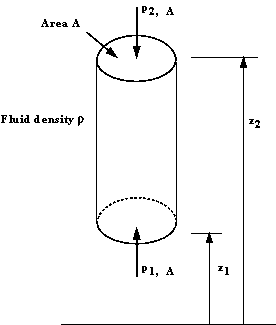
Vertical elemental cylinder of fluid
In the above figure we can see an element of fluid
which is a vertical column of constant cross sectional area, A,
surrounded by the same fluid of mass density  .
The pressure at the bottom of the cylinder is
.
The pressure at the bottom of the cylinder is  at level
at level  , and at the top is
, and at the top is  at level
at level  . The fluid is at rest and in
equilibrium so all the forces in the vertical direction sum to
zero. i.e. we have
. The fluid is at rest and in
equilibrium so all the forces in the vertical direction sum to
zero. i.e. we have

Taking upward as positive, in equilibrium we have


Thus in a fluid under gravity, pressure decreases with increase in height
 .
.
5. Equality Of Pressure At The Same Level In A Static Fluid
Consider the horizontal cylindrical element of fluid
in the figure below, with cross-sectional area A, in a fluid of
density  , pressure
, pressure  at the left hand end and pressure
at the left hand end and pressure  at
the right hand end.
at
the right hand end.
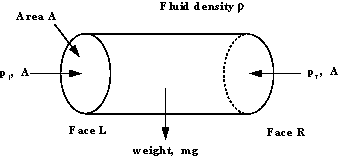
Horizontal elemental cylinder of fluid
The fluid is at equilibrium so the sum of the forces acting in the x direction is zero.


Pressure in the horizontal direction is constant.
This result is the same for any continuous fluid. It is still true for two connected tanks which appear not to have any direct connection, for example consider the tank in the figure below.
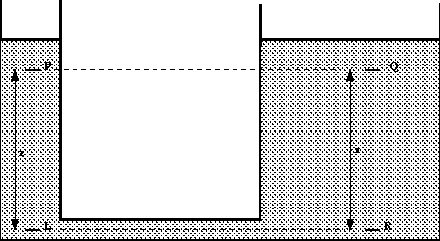
Two tanks of different cross-section connected by a pipe
We have shown above that  and
from the equation for a vertical pressure change we have
and
from the equation for a vertical pressure change we have

and

so

This shows that the pressures at the two equal levels, P and Q are the same.
6. General Equation For Variation Of Pressure In A Static Fluid
Here we show how the above observations for vertical and horizontal elements of fluids can be generalised for an element of any orientation.
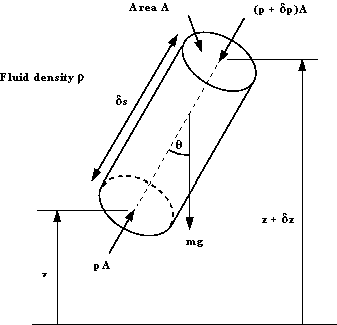
A cylindrical element of fluid at an arbitrary orientation.
Consider the cylindrical element of fluid in the
figure above, inclined at an angle  to
the vertical, length
to
the vertical, length  , cross-sectional
area A in a static fluid of mass density
, cross-sectional
area A in a static fluid of mass density  .
The pressure at the end with height
.
The pressure at the end with height  is
is
 and at the end of height
and at the end of height  is
is .
.
The forces acting on the element are


There are also forces from the surrounding fluid acting normal to these sides of the element.
For equilibrium of the element the resultant of forces in any direction is zero.
Resolving the forces in the direction along the central axis gives

Or in the differential form

If  then s is in the
x or y directions, (i.e. horizontal),so
then s is in the
x or y directions, (i.e. horizontal),so

Confirming that pressure on any horizontal plane is zero.
If  then s is in the
z direction (vertical) so
then s is in the
z direction (vertical) so

Confirming the result

7. Pressure And Head
In a static fluid of constant density we have the
relationship  , as shown above. This can
be integrated to give
, as shown above. This can
be integrated to give

In a liquid with a free surface the pressure at any depth z measured from the free surface so that z = -h (see the figure below)
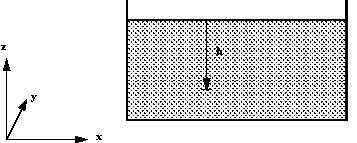
Fluid head measurement in a tank.
This gives the pressure

At the surface of fluids we are normally concerned
with, the pressure is the atmospheric pressure,  .
So
.
So

As we live constantly under the pressure of the atmosphere, and everything else exists under this pressure, it is convenient (and often done) to take atmospheric pressure as the datum. So we quote pressure as above or below atmospheric.
Pressure quoted in this way is known as gauge pressure i.e.
Gauge pressure is

The lower limit of any pressure is zero - that is the pressure in a perfect vacuum. Pressure measured above this datum is known as absolute pressure i.e.
Absolute pressure is

As g is (approximately) constant, the gauge
pressure can be given by stating the vertical height of any fluid
of density  which is equal to this pressure.
which is equal to this pressure.

This vertical height is known as head of fluid.
Note: If pressure is quoted in head, the density of the fluid must also be given.
Example:
We can quote a pressure of  in terms of the height of a column of water of density,
in terms of the height of a column of water of density,  .
Using
.
Using  ,
,

And in terms of Mercury with density,  .
.

